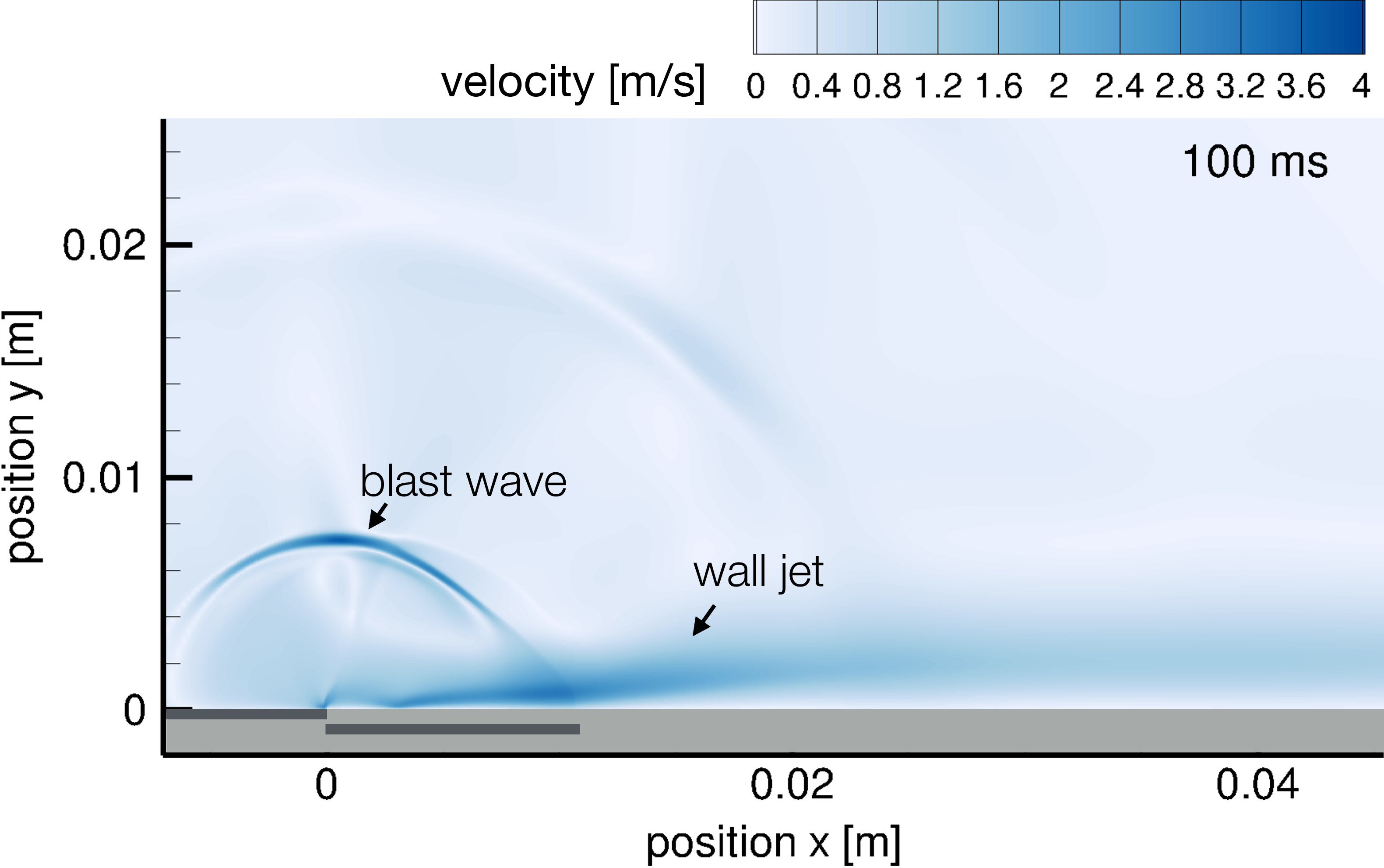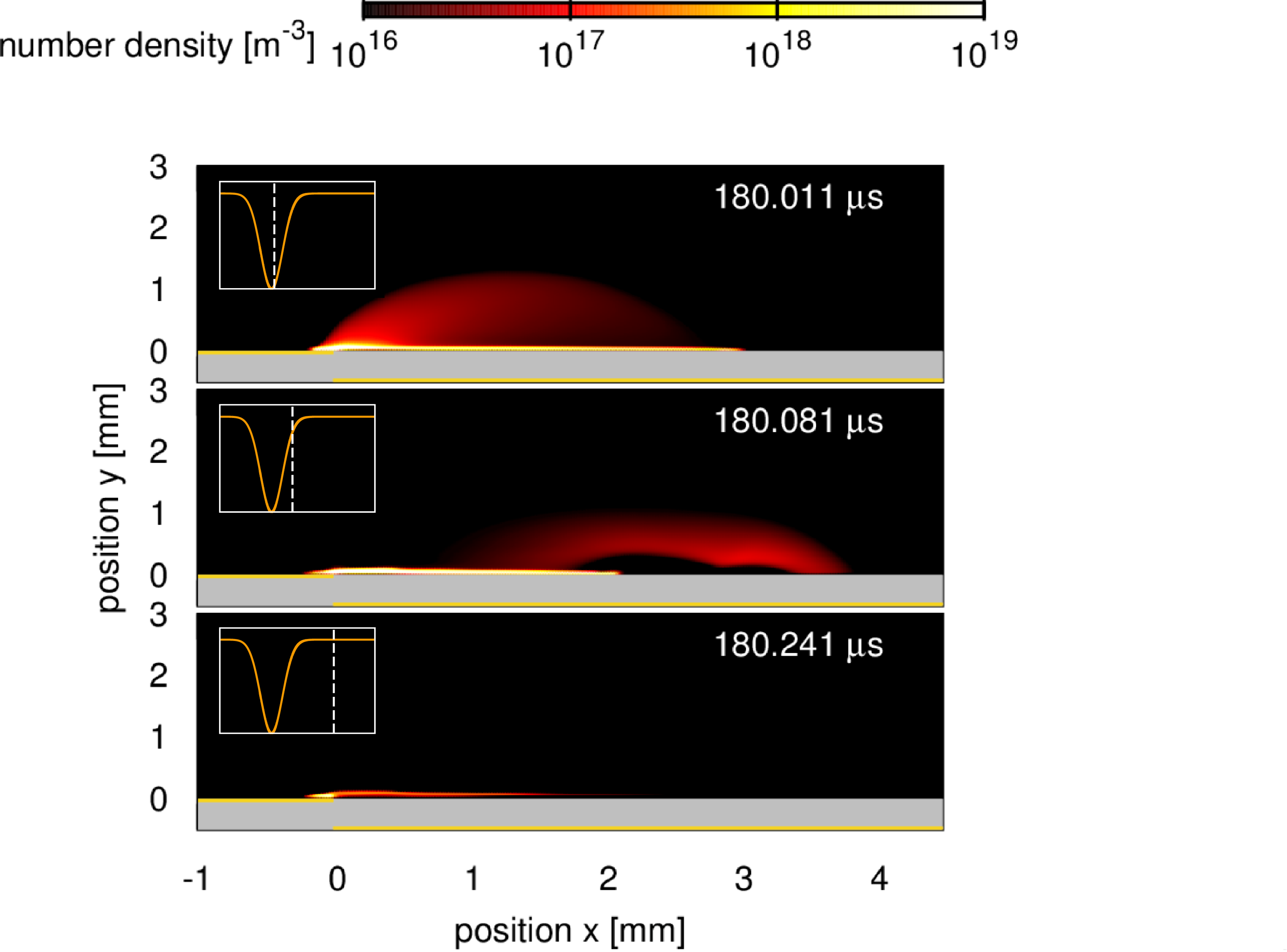Fluid-discharge coupling simulation in DBD plasma actuator
JAXA Supercomputer System Annual Report April 2017-March 2018
Report Number: R17EACA16
Subject Category: JSS2 Inter-University Research
- Responsible Representative: Naofumi Ohnishi, Tohoku University
- Contact Information: Naofumi Ohnishi ohnishi@rhd.mech.tohoku.ac.jp
- Members: Naofumi Ohnishi, Shintaro Sato
Abstract
Dielectric-Barrier-Discharge Plasma Actuators (DBD-PAs) are novel active-flow-control devices using electrohydrodynamic force caused by atmospheric discharge. However, the practical application of the DBD-PA is still challenging due to the low induced flow-velocity. In order to improve the DBD-PA performance, clarification of the discharge process is a key issue because the flow is induced through the complicated discharge process. In this study, the discharge-fluid coupling simulation is conducted for the elucidation of the detailed discharge process and the proposal of the applied voltage-waveform which is suitable for the electrohydrodynamic force generation.
Reference URL
Please refer to '大西・高橋研究室'.
Reasons for using JSS2
The numerical simulation requires enormous computational cost because both the discharge process, which has a nanosecond time scale, and the induced-flow process, which has a millisecond time scale, should be taken into account. In addition, we solve the equation of motion of the charged particle and the Poisson's equation for the electrical potential for every time step in the discharge simulation, requiring the supercomputer. In order to investigate the effect of the applied voltage waveform on the discharge process and the induced-flow structure, we should conduct a parametric study of the applied voltage waveforms by using the JSS2.
Achievements of the Year
We proposed a two-stroke cycle DBD plasma actuator, which is driven by a DC voltage combined with nanosecond pulse voltage, focusing on the cycle of the dielectric surface charge. Enhancement of the electrohydrodynamic force was demonstrated in our numerical simulation compared to the sinusoidal waveform case (Fig. 1). On the one hand, the sinusoidal voltage forms four strokes depending on the dielectric surface charge; on the other hand, the DC-biased nanosecond pulse forms two strokes. A high constant voltage is desirable for the charged particle acceleration, and a nanosecond pulse is suitable for the charged particle generation and neutralization of the dielectric surface charge.
The induced flow simulation was also conducted using a data map, which was created by the discharge simulation because it is not realistic to run a simulation for tens of milliseconds by coupling flow and discharge models. Our simulation result shows that the wall jet is formed by the two-stroke cycle operation and the blast waves are repetitively generated with the same frequency as the pulse repetition rate due to the localized heating in the vicinity of the exposed electrode tip (Fig. 2).

Fig.2: Distribution of the induced velocity magnitude in the quiescent air when the 8-kV DC voltage combined with the 25 kHz nanosecond pulses is applied
Publications
■ Peer-reviewed papers
1) S. Sato, M. Takahashi, and N. Ohnishi, 'Enhanced electrohydrodynamic force generation in a two-stroke cycle dielectric-barrier-discharge plasma actuator', Applied Physics Letters 110, 194101 (2017).
2) S. Sato, M. Takahashi, and N. Ohnishi, 'Computational study of body force production process and performance improvement in dielectric-barrier-discharge plasma actuator', Transactions of the Japan Society for Aeronautical and Space Sciences, Aerospace Technology Japan, accepted.
■ Non peer-reviewed papers
1) S. Sato, M. Takahashi, and N. Ohnishi, 'Induced flow simulation with detailed discharge modeling in dielectric-barrier-discharge plasma actuator', AIAA paper 2018-1293 (2018).
■ Presentations
1)S. Sato, M. Takahashi, and N. Ohnishi, 'Computational study of body force production process and performance improvement in dielectric-barrier-discharge plasma actuator', 31st International Symposium on Space Technology and Science, 26th International Symposium on Space Flight Dynamics & 8th Nano-Satellite Symposium, Matsuyama, June 3-9, 2017.
2) S. Sato, M. Takahashi, and N. Ohnishi, 'Numerical analysis of discharge process and induced flow in DBD plasma actuator', Tokyo, June 28-30, 2017.
3) S. Sato, M. Takahashi, and N. Ohnishi, 'Control of dielectric surface charge toward performance improvement in DBD plasma actuator', Saitama, September 3-6, 2017.
4) S. Sato, M. Takahashi, and N. Ohnishi, 'Numerical analysis of induced flow with discharge process in DBD plasma actuator', Kyoto, December 12-14, 2017.
5) S. Sato, M. Takahashi, N. Ohnishi, 'Induced flow simulation with detailed discharge modeling in dielectric-barrier-discharge plasma actuator', AIAA SciTech Forum, Kissimmee, Florida, January 8-12, 2018.
Usage of JSS2
Computational Information
- Process Parallelization Methods: MPI
- Thread Parallelization Methods: N/A
- Number of Processes: 160 - 320
- Elapsed Time per Case: 120.00 hours
Resources Used
Fraction of Usage in Total Resources*1(%): 0.31
Details
Please refer to System Configuration of JSS2 for the system configuration and major specifications of JSS2.
| System Name | Amount of Core Time(core x hours) | Fraction of Usage*2(%) |
|---|---|---|
| SORA-MA | 2,544,476.92 | 0.33 |
| SORA-PP | 3,464.08 | 0.04 |
| SORA-LM | 0.00 | 0.00 |
| SORA-TPP | 0.00 | 0.00 |
| File System Name | Storage Assigned(GiB) | Fraction of Usage*2(%) |
|---|---|---|
| /home | 195.50 | 0.14 |
| /data | 9,813.31 | 0.18 |
| /ltmp | 2,929.69 | 0.22 |
| Archiver Name | Storage Used(TiB) | Fraction of Usage*2(%) |
|---|---|---|
| J-SPACE | 0.99 | 0.04 |
*1: Fraction of Usage in Total Resources: Weighted average of three resource types (Computing, File System, and Archiver).
*2: Fraction of Usage:Percentage of usage relative to each resource used in one year.
JAXA Supercomputer System Annual Report April 2017-March 2018



